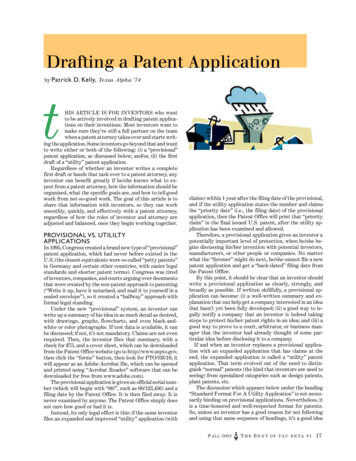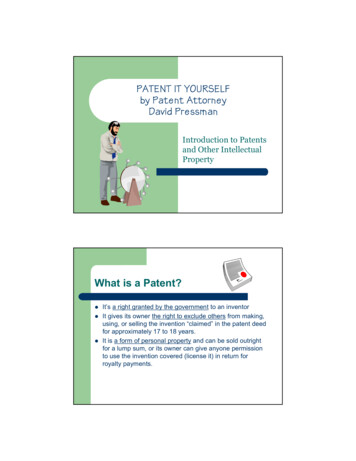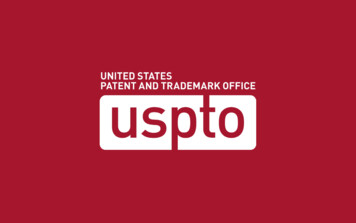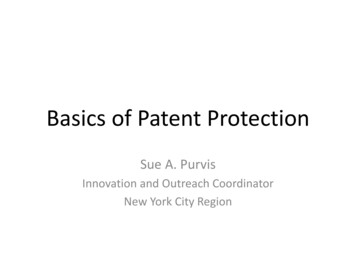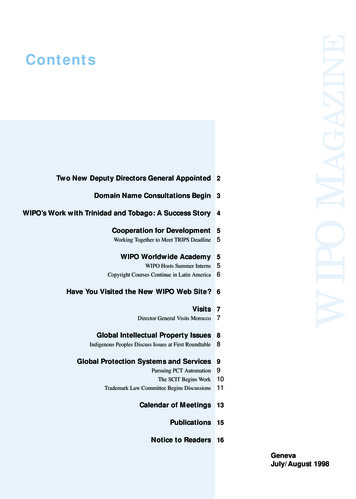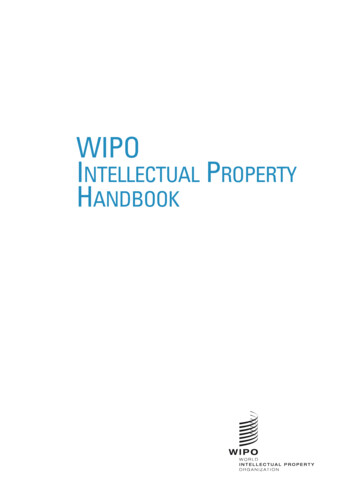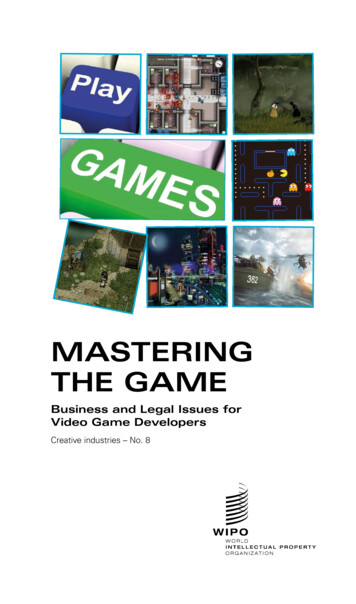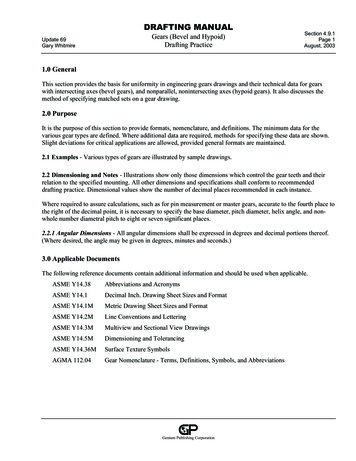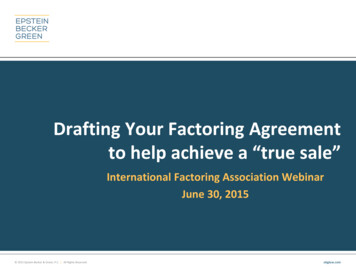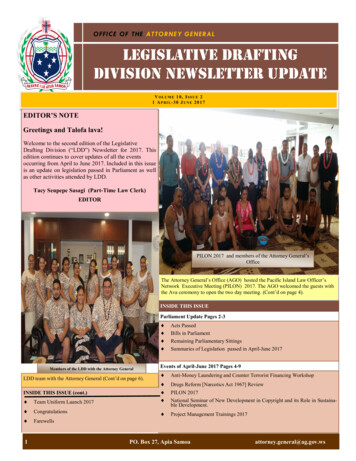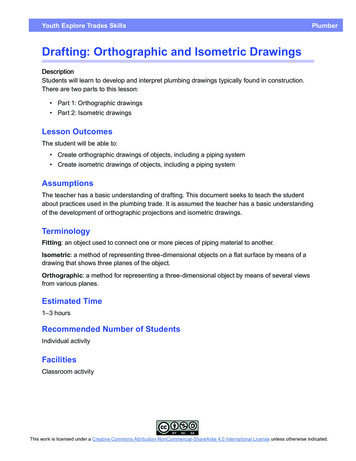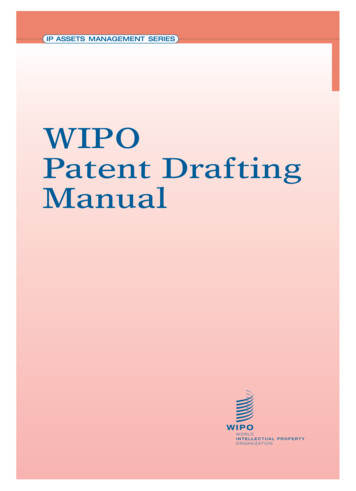
Transcription
867E-STL-INT 2010 867E-STL-PDM 02.11.10 11:17 Page1IP ASSETS MANAGEMENT SERIESWIPOPatent DraftingManual
867E-STL-INT 2010 867E-STL-PDM 02.11.10 11:17 Page22PREFACEFour years ago, in response to requests from Member States, the WIPO Secretariat began to examine the practical impact of the lack of patent drafters on the ability of inventors in developing countries to use the IP system, and, thereby, to participate in the economic benefits of intellectual property. Study and analysis confirmedthe need for capacity-building in this area; a need recognized by Member States, which were increasinglyrequesting that the Organization provide capacity-building programs for patent drafting. This “Patent DraftingManual” was prepared in response to that need. It was developed by experts in the field and tested in training programs prior to publication. It is designed to assist inventors, and those providing services to them, toacquire the technical skills necessary to prepare and file patent applications, including the capacity to draft theall-important claims that determine the scope and coverage of the protection to be granted by the patent.WIPO would like to express its appreciation to the principal author of this work, Thomas Ewing (USA) for sharing his expertise as a patent attorney and for his tireless efforts in teaching and preparing training materials forthe courses based on this Manual. Valuable contributions were also made by Carlos Olarte (Colombia), KanikaRadhakrishnan (India and USA), Markus Engelhard (Germany), Wendy Herby (USA), Professor Karuna Jain(India), Emmanuel Jelsch (Switzerland), Sorin Schneiter (Switzerland), Douglas Weinstein (USA), Takashi Fujita(Japan), Karl Rackette (Germany), Samuel Le Cacheux (France), Valérie Gallois (France), Albert Jacobs (USA) aswell as various WIPO officials. WIPO is also grateful to the Geneva International Academic Network (GIAN) forits financial support in the development and testing of this publication and associated training materials.Appreciation is also due to the Member States that provided pilot sites for testing the Manual and associated training materials: Cameroon, Colombia, India, Morocco and Singapore.It is hoped that this Manual will prove an effective tool for those Member States seeking to strengthen, refineand expand their capacity to assist inventors to protect their intellectual property through carefully craftedpatent applications.
867E-STL-INT 2010 867E-STL-PDM 02.11.10 11:17 Page3W I P O P AT E N T D R A F T I N G M A N U A L3TABLEI.INTELLECTUAL PROPERTY – AN trial ApplicationNon-Obviousness/Inventive StepPREDICTING PATENTABILITY THROUGH PRIOR ART SEARCHES1.2.3.4.5.III.What is a Patent?What can be the Subject of a Patent?a.Mechanical Devices and Articles of Manufactureb.Processes/Methodsc.Chemical Compositions or Compoundsd.Isolated and Characterized Moleculese.Genetic Organisms/Gene Sequencesf.Computer Programsg.ImprovementsWhy are Patents Important?a.Revenue Sourceb.Marketing Benefitc.Bargaining Chipd.Industry Control/Influencee.Defensive UsesLEGAL REQUIREMENTS FOR PATENTABILITY1.2.3.What is Prior Art?Significance of Prior Art SearchesHow to Search Prior ArtClassification SystemsWhere to SearchPATENT APPLICATION PREPARATIONA.B.ANDFILINGPREPARING PATENT APPLICATIONS1.2.3.Obtaining Invention Disclosures from InventorsIdentifying Patentable InventionsUnderstanding the InventionTYPICAL PARTS OF THE PATENT APPLICATIONS1.2.3.4.5.6.ClaimsDetailed Description or NTS611DETAILED OVERVIEW OF 122252525262627292931323233343538404142
867E-STL-INT 2010 867E-STL-PDM 02.11.10 11:17 Page44C.FILING PATENT APPLICATIONS1.2.3.4.5.IV.V.PROSECUTING PATENT APPLICATIONS59A.B.C.D.E.6161626565RESPONDING TO OFFICE ACTIONSDRAFTING RESPONSESGETTING CLAIMS ALLOWEDOPPOSITION PROCEEDINGSISSUANCE OF THE PATENTPATENT CLAIM DRAFTINGA.B.THEORY OF THE PATENT CLAIMPATENT CLAIM FORMAT1.2.3.4.5.6.7.8.9.C.Parts of a Claim: Preamble, Transitional Phrase and the BodyTwo-Part Claims or Improvement ClaimsMeans-Plus-Function ClaimsClaim PunctuationProper Antecedent BasisReference Numerals and Bracketed ExpressionsClaim PhrasesMultiple ElementsAlternative ElementsCLAIM SETS1.2.3.VI.Domestic/Priority FilingsForeign FilingsFee and Cost Considerations in Application FilingsApplication Filing Requirements in Specific Jurisdictionsa.European Patent Convention Filingsb.US Patent and Trademark Office Filingsc.Patent Cooperation Treaty FilingsComparative Laws and Requirements444445464848495055Independent ClaimsDependent ClaimsMultiple Dependent ClaimsSPECIFIC TYPESA.B.C.D.E.F.G.H.OFCLAIMSAPPARATUS OR DEVICE CLAIMSMETHOD CLAIMS OR PROCESS CLAIMSPRODUCT-BY-PROCESS CLAIMSRESULT TO BE ACHIEVED AND PARAMETER CLAIMSDESIGN CLAIMSPLANT PATENT CLAIMSCOMPOSITION CLAIMSBIOTECHNOLOGY 878788
867E-STL-INT 2010 867E-STL-PDM 02.11.10 11:17 Page5W I P O P AT E N T D R A F T I N G M A N U A L5TABLEI.J.K.OFCONTENTSUSE CLAIMSSOFTWARE CLAIMSOMNIBUS CLAIMS888989VII. PATENT CLAIM DESIGNA.B.C.D.E.F.G.H.I.J.K.L.M.N.O.P.Q.91PREPARE THE CLAIMS FIRSTBROAD AND NARROW CLAIMSCLARITY, CLAIM WORD CHOICE, AND INCONSISTENCIESCLAIM VARIATIONS AND MODIFICATIONS OF THE INVENTIONAVOID UNNECESSARY LIMITATIONSNEGATIVE LIMITATIONS AND DISCLAIMERSTHE CLAIMS AND COMPETING PRODUCTSTHE CLAIMS MUST OVERCOME THE PRIOR ARTUSE MULTIPLE CLAIM TYPES FOR THE SAME INVENTIONMAKE SURE THAT THE SPECIFICATION SUPPORTS THE CLAIMSUNITY OF INVENTIONCLAIM POINT OF VIEWNARROWING A PATENT CLAIM DURING PROSECUTIONEXCLUSIONS FROM PATENTABILITYTHE REQUIREMENT FOR INDUSTRIAL APPLICATION“READING” A PATENT CLAIM ON SOMETHINGCLAIM CONSTRUCTION BY COURTSVIII. PATENT STRATEGYA.B.C.IX.115OFFENSIVE BLOCKING PATENTING TO MOUNT ATTACKS ON COMPETITORSDEFENSIVE PATENTING TO DEFEND ONESELF FROM INFRINGEMENT ACTIONSDESIGN-AROUND TECHNIQUESORGANIZING, EDUCATING, AND MOTIVATING THE TECHNICAL TEAMA.B.C.D.E.TRAINING MANAGEMENT PERSONNEL AND MARKETING PERSONNELTO UNDERSTAND THE SIGNIFICANCE OF PATENTS AND PORTFOLIO BUILDINGTRAINING SCIENTISTS/TECHNOLOGISTS TO UNDERSTAND WHAT MIGHT BE PATENTABLE,WHO MIGHT BE A CO-INVENTOR AND PREPARING INVENTION DISCLOSURESSETTING UP IN-HOUSE PATENT REVIEW COMMITTEE TO PERIODICALLY REVIEWINVENTION DISCLOSURES AND RECOMMEND WHAT SHOULD BE PATENTEDINVENTOR INCENTIVE PROGRAMS TO ENCOURAGE INVENTORS TO INVENT AND REPORTPROFESSIONAL ETHICSAPPENDIX AINSTRUCTIONSAPPENDIX BSAMPLE INVENTION DISCLOSURE 2113FORSEARCHOFPATENT DATABASES116117118120120122123124125128130133
867E-STL-INT 2010 867E-STL-PDM 02.11.10 11:17 Page66I.INTELLECTUEL PROPERTY –AN INTRODUCTIONIntellectual Property (IP) is the name given to patents, trademarks, copyrights, industrial designs and other typesof intangible property that arise from creations of the mind and in their broadest sense have no physical form.PROPERTYRealPersonalCapitalIntellectualVALUE CREATIONACTIVITYProduct CreationInvestmentImprovementSaleRent or tionSolution ofNeedsLike all types of property, IP is owned and can generate income. For this reason IP is considered an asset. Itis often the result of investment and should generate a return of one sort or another. IP differs from othertypes of property because it has no physical form and comes into being because of human intelligence, creativity and imagination.There are different types of IP each with its own unique laws. IP is sometimes divided into two general categories, “industrial property” and “copyright.” Industrial property refers to assets created primarily for theadvancement of technology, industry and trade such as patents (inventions), industrial designs, trademarks,service marks, trade secrets and geographic indications of origin.1 The most common forms of IP are:Patents: A patent is a legal document granting its holder the exclusive right to control the use of an invention, as set forth in the patent’s claims, within a limited area and time by stopping others from, among otherthings, making, using or selling the invention without authorization. For example, patents could be grantedfor a battery that efficiently stores solar energy indefinitely and without loss, a vaccine to protect againstmalaria or a new compound for transforming fish bones into agricultural fertilizer.Industrial Designs: Industrial design protection allows its owner to control the exploitation of the ornamental shapes associated with products such as the stylish shape of a new sports car, the distinctive plastic casing of a certain type of computer or the shape of a soft drink bottle.Trademarks: A trademark allows its owner to confirm the origin of his goods to the public. Examples of trademarks include the distinctive names of products such as Nando’s or Coca Cola or a logo such as theMercedes Benz triad symbol.Service Marks: A service mark is a form of trademark that allows its owner to verify the origin of a service tothe public such as “Cheques for Two .”Copyright: A copyright refers to original expressions and “works of authorship.” The person who creates acopyrighted work is called an author. Examples of copyrighted works include: paintings, photography, music,dances, poems, novels etc. In addition, copyright applies to some technical things that have an element oforiginality such as computer software, technical specifications and related documentation.1. Article 1(2) of the Paris Convention for the Protection of Industrial Property (Stockholm Act, 1967), reads as follows: “The protection ofindustrial property has as its object patents, utility models, industrial designs, trademarks, service marks, trade names, indications of source orappellations of origin and the repression of unfair competition.”
867E-STL-INT 2010 867E-STL-PDM 02.11.10 11:17 Page7W I P O P AT E N T D R A F T I N G M A N U A L7One difference between copyrights and industrial property is that generally copyrights do not require registration with a government authority as a condition for protection against unauthorized use. Industrial property rights, on the other hand, must be expressly granted by, and registered with, a government authoritybefore they can be recognized and enforced. In theory, anyone can draft a patent or a trademark applicationbut in practice, professionals including lawyers (patent attorneys) and technical professionals called “patentagents” or “patent engineers” write patent applications and file them with government authorities becausethese applications can be technically and procedurally complex.This manual deals with patents and how they are applied for and registered. The objective of this manual is to helpthe reader to develop a general understanding of the skills needed for drafting a patent application, filing it andworking with patent authorities to have it issued as a patent. Since national/regional laws and practices may varysignificantly, the reader must also review and understand the specific requirements for the jurisdictions of interest to his client. Note that in this manual we will sometimes use the term “patent agent;” this term is not used inthe technical sense of a professional who is certified by national authorities to represent inventors in defined circumstances but rather as a generic term to cover anyone who drafts a patent application (including inventors,patent drafters, patent agents and patent attorneys).MORE PATENT BASICSPatents may be granted to protect inventions that are new, involve an inventive step and are capable of industrial application.2 The patent has to be for an invention that works, or as it is put in some countries, the invention must be capable of being “reduced to practice.” Thus, a clever notion that cannot presently work (e.g.a time machine) cannot be patented. Different countries have different ways of expressing the criteria forpatents. For example, patents must generally be technical in nature but not all jurisdictions have the samedefinitions for what is “technical” and what is not technical.The term of a patent is generally twenty years from the filing date of the patent application. A patent givesits owner the right to exclude others from making, using, offering for sale or selling the invention or importing the patented invention into the country where the patent has been granted. In other words, a patent provides a property right that allows the owner to say who cannot use the invention protected by the patent.Anyone who is not the patent owner or who is not licensed by the patent owner and who manufactures,uses, imports, offers for sale or sells the patented invention is called an “infringer.” An infringer can be suedin court to force him to stop the infringement and to pay the owner damages.Patents are “territorial;” they have effect only in countries where they have been applied for and granted.Each country has the sovereign right to grant or refuse to grant patent applications. In a few instances suchas the European Patent Office (EPO), groups of nations have agreed by treaty to provide for common examination of patent applications. Some countries have also agreed by treaty to accept patents granted by othernations.3 For example, some former British colonies will accept patents approved by the UK Patent Officeand/or the EPO when the UK is a designated country in the EPO application.Below is a representative patent. This particular patent, EP 1 242 397 B1, was granted by the EPO onSeptember 29, 2005. The patent bears the title “Trans Olefinic Glucokinase Activators.” Although theapplication was filed with the EPO via the PCT on December 12, 2000, the application claims the priority2. This definition comes from Article 27.1 of the Trade Related Aspects of Intellectual Property Rights (TRIPS) Agreement. Some countriesreplace “industrial step” with “non-obvious” and “industrial application” with “useful.” These terms are synonymous but not identical, as willbe discussed.3. Where applicable, the precise procedures vary and the applicant may need to take some procedural steps while the original application isstill pending. Consequently, when the patent agent’s client is interested in obtaining patent protection via this route, the patent agent mustunderstand very early in the application process what procedural steps will be required.
867E-STL-INT 2010 867E-STL-PDM 02.11.10 11:17 Page88filing date under the Paris Convention of US Provisional Application No. 60/170,783, which was filed onDecember 15, 1999. Thus, the effective date for prior art against this patent is December 15, 1999. Thepublished PCT application, WO2001/044216, included the following abstract for the invention represented by the patent application:2,3-Di-substituted trans olefinic N-heteroaromatic or urido proprionamides of formula (I) withsaid substitution at the 2-position being a substituted phenyl group and at the 3-positionbeing a cycloalkyl ring, said proprionamides being glucokinase activators which increaseinsulin secretion in the treatment of type II diabetes.The preamble to the main independent claim for the EPO patent reads: “Compound selected from the groupconsisting of an olefinic amide of the formula ” and then shows a chemical diagram followed by a verydetailed description of the novel compound.
867E-STL-INT 2010 867E-STL-PDM 02.11.10 11:17 Page9W I P O P AT E N T D R A F T I N G M A N U A L9
867E-STL-INT 2010 867E-STL-PDM 02.11.10 11:17 Page1010KEY WORDS PATENT INDUSTRIAL PROPERTY TRADEMARK SERVICE MARK TERM OF PATENT INVENTION ASSET NOVELTY UTILITY REDUCED TO PRACTICE TERRITORIAL INFRINGEMENTSELF TEST1.What is intellectual property?2.Why is IP an asset?3.What is the difference between industrial property and copyright?4.Can a software code be protected by copyright?5.How long does a patent generally last?6.A patent has to be new, useful and non-obvious. True or false?7.A patent gives its owner the right to exclude others from making, using or selling the invention setforth in the patent’s claims. True or false?8.Give an example of each type of IP that you can see in the room where you are now.9.Once a patent has been issued in one country it is entitled to recognition all over the world. True or false?10.Patent applications can be written by anyone but it is best if they are drafted by someone whoknows how to do it. True or false?
867E-STL-INT 2010 867E-STL-PDM 02.11.10 11:17 Page11W I P O P AT E N T D R A F T I N G M A N U A L11II. PATENTSA.DETAILED OVERVIEW OF PATENTSA patent is an award of a limited monopoly from a government for an invention. In the past, governmentsawarded patents for almost any good or service, whether or not an invention was involved. For example, aking might bestow a patent on salt to a trusted ally. In modern times governments have reduced the scopeof patents to protect inventions only. The Republic of Venice created one of the first patent systems of themodern era. The original term for a patent was set at 14 years, twice the length of the average apprenticeship. The term was later extended to 17 years following the grant of the patent. At present most patent termsare set at 20 years from the date of the application’s filing.1.What is a Patent?The patent must also satisfy other legal requirements such as certain time limits related to how long the invention was disclosed to the public, if at all, prior to the filing of the patent application. Generally, patents willbe denied if the invention has been made public prior to the filing of the application, excluding any graceperiod that may apply. In some countries such as the United States, there is a one-year grace period duringwhich the application can still be filed; in most other countries a public disclosure of the invention before theapplication is filed is typically sufficient to cause the patent application to be denied.4 In some jurisdictions,patents cannot be obtained for inventions that are contrary to the “ordre public” or “immoral.” For example, inventions relating to a device foringesting an illegal narcotic (e.g. anopium pipe) might be unpatentable onA patent application must be filed before publicly disclosingmoral grounds. However, this restrictionany important research results that may lead to a valuablecan sometimes be more a matter ofproduct or technology. This caution especially applies topatent claim format than an absoluteresearch institutions – but the necessity for publishing acaprohibition. Not all jurisdictions have thedemic works can easily be accommodated by a publicationsame definitions for morality and someclearance procedure that reviews journal and conference subjurisdictions opt not to have their patentmissions for patentable novelty.laws weigh on morality issues.Most patents nowadays are produced by “substantive examination systems” in which the patent application is thoroughly reviewed by a government-employed patent examiner. Among other things, the patentexaminer will compare the prior art relating to a pending application against the application’s claims todetermine if the claimed invention provides a legally sufficient advance over the prior art. A few countriesstill maintain “registration systems” in which an applicant receives a patent once certain formalities havebeen completed but without the patent application undergoing a substantive examination. In such systems,it is not until the patent is later challenged in court that the issue of whether the patent is invalid becauseof prior art is studied.4. Article 11 of the Paris Convention, for example, provides an exception to the typical rule regarding public disclosure. The patent agent mustunderstand the specific procedural and substantive requirements in all jurisdictions of interest to his client.PROFESSIONAL TIPA patent generally grants the patent owner the exclusive right to control who makes, uses, sells, offers forsale and/or imports any product or technology protected by the patent’s claims. Patent claims are sets of sentences, typically appearing at the end of the patent, that describe the invention being protected. In order toobtain a patent, the patent’s claims must typically describe an invention that is new, useful and non-obviousin view of the “prior art.” Prior art is a technical term that generally refers to all the public knowledge andinventions that existed before the patent application’s filing.
867E-STL-INT 2010 867E-STL-PDM 02.11.10 11:17 Page1212A patent is said to be valid once it has been granted and has not had a successful challenge against it in acourt or before the relevant patent office. A patent is said to be invalid when it is rejected or cancelledbecause the invention is not new (prior art) or for other reasons. Most of the world’s patent systems hold thatpatents are presumed valid and must be legally proven otherwise. This is especially true in examination systems where an impartial government official has reviewed the patent application and the relevant prior artbefore granting the patent. The world’s patent laws typically recognize patent protection for different typesof inventions. Many patent systems essentially aim to provide uniform treatment for all inventions, regardlessof the type of invention. When people speak of patents they usually mean “patents of invention” which aresometimes known as “utility patents.” These patents protect machines, processes, chemical compositionsand the other kinds of inventions that are valuable because of their usefulness. The bulk of this manual relatesto patents of invention or utility patents.Some countries also provide patents or patent-like legal instruments for other types of inventions. For example, in some countries designs may be protected as “design patents” (e.g. the US). In other countries designsare protected under industrial design registration systems (e.g. Belgium). In either case the protection is for anew, original and ornamental design for an article of manufacture, not the functionality.Where it exists, the term of protection for a design patent may differ from that of a utility patent. In the USthe term for a utility patent is 20 years from the earliest US filing date relied upon by the applicant, while theterm for a design patent is 14 years from the date of the patent grant. Design patents typically bear similarities both to trademarks and utility patents. For example, a manufacturer produces a coffee pot having aunique shape. The coffee pot itself may or may not offer inventive features that could be the subject of a utility patent application. However, the manufacturer may be interested in protecting the unique shape of hiscoffee pots. In fact, he may have learned that the public associates the shape of his coffee pots with the company’s name. Consequently, the manufacturer would like to be able to prevent other manufacturers frombeing able to freely copy the unique shapes given to his coffee pots.A patent applicant may not need to choose between filing a utility patent application and seeking protection for a unique design. The patent applicant may often seek protection for both inventive features anddesign elements. Assume, for example, that the manufacturer above developed the shape of his coffee potsbased on his own research into heat loss. He could then file a utility patent application that protects theinvention associated with preventing heat loss in coffee pots while also filing a design patent application ontheir unique shape.Some countries offer protection for inventions by means of “utility model registrations” which are also knownas “petty patents” or “utility innovations.” The requirements for the registration of utility models are typicallyless stringent than the requirements for obtaining a patent of invention. Conversely, the breadth of protection afforded a utility model is not usually as strong as that provided by a patent of invention.In practice, protection for utility models is typically sought for innovations of an incremental nature thatmight not satisfy the criteria for patents of invention, e.g. inability to demonstrate inventive step. The termof protection for utility models is significantly shorter than for patents. Some patent offices do not examineutility model applications substantively prior to registration. Consequently, the precise nature of the rightgranted will be in question until a dispute arises between the owner and another party. In some countries,utility model protection can only be obtained for certain fields of technology and only for products but notfor processes.
867E-STL-INT 2010 867E-STL-PDM 02.11.10 11:17 Page13W I P O P AT E N T D R A F T I N G M A N U A L13Similarly, some countries provide patent protection for plants produced in a specific manner.5 For example, in theUS, plant patents may be obtained on “any distinct and new variety of plant, including cultivated sports,mutants, hybrids, and newly found seedlings, other than a tuber propagated plant or a plant found in an uncultivated state.” Many countries do not allow the patenting of plants regardless of their means of propagation.2.What can be the Subject of a Patent?The subject matter of a patent refers to what can be patented. In some countries, virtually any invention canbe patented. Other countries have somewhat more restrictive definitions of patentable subject matter. In bothcases, a wide variety of things can be patented as long as they are new, useful and non-obvious.6Let’s look at another issued patent: US Patent No. 6,434,955 issued on August 20, 2002 bearing the title“Electro-Adsorption Chiller: A Miniaturized Cooling Cycle With Applications From Microelectronics ToConventional Air-Conditioning.” The abstract for this patent reads:A novel modular and miniature chiller is proposed that symbiotically combines absorption andthermoelectric cooling devices. The seemingly low efficiency of each cycle individually is overcome by an amalgamation with the other. This electro-adsorption chiller incorporates solelyexisting technologies. It can attain large cooling densities at high efficiency, yet is free of moving parts and comprises harmless materials. The governing physical processes are primarilysurface rather than bulk effects, or involve electron rather than fluid flow. This insensitivity toscale creates promising applications in areas ranging from cooling personal computers andother micro-electronic appliances, to automotive and room air-conditioning.While the patent examiner assigned to review this application ultimately found patentability, he neverthelessreviewed nearly 15 pieces of prior art and used two pieces of this prior art in rejecting the claims of the application as originally filed. The issued patent has 19 claims in two sets, with one set of 11 device claims followed by a second set of seven method claims.5. For example, the “asexually propagated plants” that may be protected in the US are plants reproduced by means other than from seeds,such as by the rooting of cuttings, by layering, budding, grafting and inarching.6. The TRIPS Agreement in Article 27.1, footnote 5, states that “useful” and “non-obvious” are synonymous terms to “industrial application”and “inventive step.” The terms are not exactly identical, however.
867E-STL-INT 2010 867E-STL-PDM 02.11.10 11:17 Page1414
867E-STL-INT 2010 867E-STL-PDM 02.11.10 11:17 Page15W I P O P AT E N T D R A F T I N G M A N U A L15It may be useful to review some categories of subject matter that are commonly patented and so the following discussion addresses various types of patentable subject matter.a.Mechanical Devices and Articles of ManufacturePatent laws protect mechanical devices and articles of manufacture. These are the traditional inventions ofpatent law. Consequently, the publicly-available prior art in these fields goes back about as far as such artcould possibly go. For example, a modern patent applicant seeking to protect an invention related to specialized hockey skates should not be surprised to find that an issued patent from the 1860s has been citedby an examiner to show that the modern patent application reads on the prior art. Note that when we saythat an application “reads on” prior art, this is a way of saying that there is prior art that is relevant to theclaims in the application.b.Processes/MethodsPatents can cover processes and methods. Many processes and methods are also related to a physical device.A patentee is not limited to seeking protection using just one type of claim. Consequently, a patent application should typically include both apparatus and method claims. So, for example, an inventor can patent hisnew apparatus for filtering and purifying plant extracts as well as his filtration method.c.Chemical Compositions or CompoundsInventors may seek patent protection for chemical compositions such as those arising in the fields of pharmaceuticals, biotechnology, materials science, and petrochemicals. For example, a patent could have beenissued long ago on aspirin, a chemical compound that relieves headaches. Patents covering pharmaceuticals,for example, tend to be the most profitable individual patents. Given that the patent application must be filedprior to public disclosure and given that rigorous testing must be conducted for new drugs, it is not uncommon for pharmaceutical companies to file many patent applications on a variety of drugs while they are stillin the early testing stages. Consequently, many of these applications are abandoned prior to issuance aspatents because the manufacturer subsequently learns that the drug is either not effective or unsafe. Manyof the world’s patent laws have prohibitions against patent protection for inventions associated with treatment of the human body. This may require special
IP ASSETS MANAGEMENT SERIES WIPO Patent Drafting M
